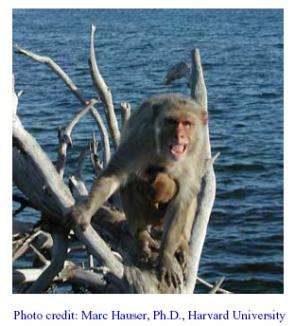Neural bases for language existed already 25-30 million years ago

The origin of the brain mechanisms involved in human language is a much debated subject, especially whether these mechanisms appeared independently in humans or were already present in a common ancestor of human and non-human primates. But now, research just published in the advanced online issue of Nature Neuroscience, found that Rhesus macaques when listening to other monkeys’ calls activate brain areas equivalent to the ones used for language in humans supporting the hypothesis that the neural basis for language existed already in a common ancestral. The discovery is a major step in understanding better language origins and evolution.
The acquisition of language is one of the most important adaptations during human evolution. Language created new human interactions and allowed ideas to bridge time and space. Among humans, babies as young as four weeks can respond to about 40 consonants, as differences in their sucking and heartbeats rates show. This ability seems to be innate, as babies from English-speaking parents react to consonants in Japanese that not exist in the English language. By the age of six, when the child enters school, the ability to react to sounds to which he/she has not been exposed in their own language is severely reduced, probably because at this point brain development rate decreases, and that is also why, after this age, it is so much more difficult to learn a second language.
Two main language centres have been identified in the human brain: Broca’s area, in the frontal lobe and Wernicke’s area, posteriorly. Both areas are found within a larger surface called the Perisylvian region, believed to be associated with language comprehension and production.
Although monkeys do not possess language, they do have an extended repertoire of sounds that have specific functions such as alerting to the presence of predators and marking various social interactions or emotional states. Interestingly, they have been shown to have regions in the brain similar to the Perisylvian area, although until now their functional significance was unknown, as was their link to the equivalent human region.
Trying to understand if these regions in the monkey were at all functionally correspondent to their human counterpart, Ricardo Gil-da-Costa, Allen R. Braun and colleagues from Portugal, the US and the UK decided to analyse the brain activity of Rhesus monkeys while listening (and recognising) other monkeys’ calls.
To this end, the researchers used an imaging technique called positron emission tomography (PET), which measures the functioning of distinct areas of the human brain with the individual still conscious and alert.
The technique consists of injecting radioactive isotopes (which are biologically safe and similar to the ones used in many exams performed in humans) into the bloodstream of the monkeys and then taking several PET images to trace the isotopes within the body. The logic is that when a task is performed and a specific brain region is activated, blood (and isotopes) rushes into this area in bigger quantities, identifying in this way the region involved in the task.
Several images were taken from animals listening to coos and screams of other rhesus monkeys, but also, as controls, to non-biological sounds, such as musical instruments and computer-synthesized noise. All these sounds were matched to have the same frequency, rate, scale, and duration as the sounds from the macaques, to assure that the results observed were a response to the calls’ meaning and not just to a particular noise.
What Gil-da-Costa, Martin, Braun and colleagues found, was that the monkeys’ brain areas homologues to the Perisylvian region in humans, were found to be significantly more activated while listening to other monkeys’ calls than to control sounds. This suggests that the most recent ancestor of human and non-human primates, that lived 25-30 million years ago, already had the neural substrate that later led, through different evolutionary processes, to the appearance of language in humans and the basic specific-meaning vocalisation found in monkeys.
“This intriguing finding brings us closer to understanding the point at which the building blocks of language appeared on the evolutionary timeline” - says James F. Battey, director of National Institute on Deafness and Other Communication Disorders in Pennsylvania - “while the fossil record cannot answer this question for us, we can turn to the here and now — through brain imaging of living non-human primates — for a glimpse into how language, or at least the neural circuitry required for language, came to be.”
Furthermore, the researchers have previously found that listening to vocalisations by other monkeys also activated brain areas associated, in humans, with the visual and emotional memories of objects.
This is extremely interesting as this result, together with the new study now published, suggests that not only monkeys and humans share a common neural basis to understand socially relevant information from vocalisations within the species, but also that language seems to come from a much broader neurological network, probably found in the Perisylvian area, which is involved in the extraction of meaning from socially relevant situations.
Link: www.nature.com/neuro/journal/v9/n8/abs/nn1741.html
Source: OCES



















